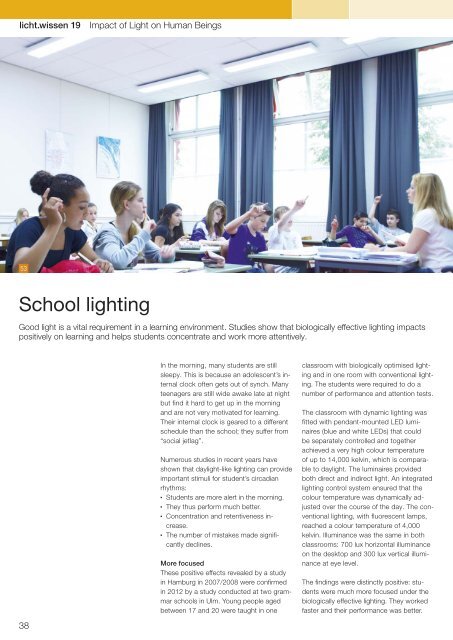licht.wissen 19 No. "Impact of Light on Human Beings"
Light synchronises our “internal clock”. Lighting that copies daylight has more than just a visual impact; it supports bodily functions 24 hours a day. Booklet 19 is intended for all those who want to delve into the topic of Impact of Light on Human Beings. The 56 pages helps to get an overview of what melanopic light can effect. Free Download at www.licht.de/en
Light synchronises our “internal clock”. Lighting that copies daylight has more than just a visual impact; it supports bodily functions 24 hours a day. Booklet 19 is intended for all those who want to delve into the topic of Impact of Light on Human Beings. The 56 pages helps to get an overview of what melanopic light can effect. Free Download at www.licht.de/en
Create successful ePaper yourself
Turn your PDF publications into a flip-book with our unique Google optimized e-Paper software.
<str<strong>on</strong>g>licht</str<strong>on</strong>g>.<str<strong>on</strong>g>wissen</str<strong>on</strong>g> <str<strong>on</strong>g>19</str<strong>on</strong>g><br />
<str<strong>on</strong>g>Impact</str<strong>on</strong>g> <str<strong>on</strong>g>of</str<strong>on</strong>g> <str<strong>on</strong>g>Light</str<strong>on</strong>g> <strong>on</strong> <strong>Human</strong> Beings<br />
53<br />
School lighting<br />
Good light is a vital requirement in a learning envir<strong>on</strong>ment. Studies show that biologically effective lighting impacts<br />
positively <strong>on</strong> learning and helps students c<strong>on</strong>centrate and work more attentively.<br />
38<br />
In the morning, many students are still<br />
sleepy. This is because an adolescent’s internal<br />
clock <str<strong>on</strong>g>of</str<strong>on</strong>g>ten gets out <str<strong>on</strong>g>of</str<strong>on</strong>g> synch. Many<br />
teenagers are still wide awake late at night<br />
but find it hard to get up in the morning<br />
and are not very motivated for learning.<br />
Their internal clock is geared to a different<br />
schedule than the school; they suffer from<br />
“social jetlag”.<br />
Numerous studies in recent years have<br />
shown that daylight-like lighting can provide<br />
important stimuli for student’s circadian<br />
rhythms:<br />
<br />
Students are more alert in the morning.<br />
<br />
They thus perform much better.<br />
<br />
C<strong>on</strong>centrati<strong>on</strong> and retentiveness increase.<br />
<br />
The number <str<strong>on</strong>g>of</str<strong>on</strong>g> mistakes made significantly<br />
declines.<br />
More focused<br />
These positive effects revealed by a study<br />
in Hamburg in 2007/2008 were c<strong>on</strong>firmed<br />
in 2012 by a study c<strong>on</strong>ducted at two grammar<br />
schools in Ulm. Young people aged<br />
between 17 and 20 were taught in <strong>on</strong>e<br />
classroom with biologically optimised lighting<br />
and in <strong>on</strong>e room with c<strong>on</strong>venti<strong>on</strong>al lighting.<br />
The students were required to do a<br />
number <str<strong>on</strong>g>of</str<strong>on</strong>g> performance and attenti<strong>on</strong> tests.<br />
The classroom with dynamic lighting was<br />
fitted with pendant-mounted LED luminaires<br />
(blue and white LEDs) that could<br />
be separately c<strong>on</strong>trolled and together<br />
achieved a very high colour temperature<br />
<str<strong>on</strong>g>of</str<strong>on</strong>g> up to 14,000 kelvin, which is comparable<br />
to daylight. The luminaires provided<br />
both direct and indirect light. An integrated<br />
lighting c<strong>on</strong>trol system ensured that the<br />
colour temperature was dynamically adjusted<br />
over the course <str<strong>on</strong>g>of</str<strong>on</strong>g> the day. The c<strong>on</strong>venti<strong>on</strong>al<br />
lighting, with fluorescent lamps,<br />
reached a colour temperature <str<strong>on</strong>g>of</str<strong>on</strong>g> 4,000<br />
kelvin. Illuminance was the same in both<br />
classrooms: 700 lux horiz<strong>on</strong>tal illuminance<br />
<strong>on</strong> the desktop and 300 lux vertical illuminance<br />
at eye level.<br />
The findings were distinctly positive: students<br />
were much more focused under the<br />
biologically effective lighting. They worked<br />
faster and their performance was better.

















